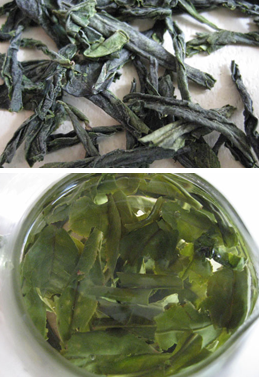|
Lu'an Guapian Tea

Known as a mild, sweet, crisp green tea with hints of smokiness, Lu'an Guapian Tea(六安瓜片)is the result of a labor intensive picking style in which the farmers cut the pointy tip end and woody stem of each leaf creating indentically sized "melon pieces". Carefully groomed leaves are then pan fired at a slow bake over a charcoal fire and frequently turned to impart a delicate hint of smokiness. This tea is one of China's top ten famous teas and originated in Anhui province in 1776 during the Qing dynasty.
The Name of Guapian Tea
Originally, Lu'an Guapian Tea was called Gua Zi Pian or “sunflower seed” because of its resemblance to the popular tea house snack. Over the years, the name has been shortened to Gua Pian causing some people to mistakenly call this tea “melon seed.” By either name, this is a special tea for its harvesting and processing techniques. The long leaves are thin and soft creating a rich flavor without bitterness. Generally speaking, Lu'an Guapian is a rare long leaf green tea with a clean bright green color, full soft flavor and long finish.
Producing areas and production of Gua Pian Tea

Lu'an Guapian is grown in Dabie Mountain in Anhui province, a mountainous area that has a misty, humid and cloudy climate which contributes to Gua Pian Tea’s superior quality. In mid April, fresh shoots are plucked with the bud and the next first, second and third tea leaves. The buds and very tender leaves are then removed and sometimes used to make another famous tea--Emerald Eyebrow. Only the first, second and third tea leaves are used to produce Lu'an Guapian tea.
The chosen leaves are withered to reduce leaf moisture and then baked and simultaneously rolled to stop oxidation and give Guapian Tea its unique melon seed shape. Then it goes through several drying processes which demand considerable skill. After drying, the tea is sorted, winnowed to remove broken tea and then graded.
As Lu'an Guapian contains tea leaves without buds and stems, it is not difficult to distinguish it from other types of Green Tea by observing dried or brewed tea leaves. The finished Guapian tea has a strong aroma and a refreshing and sweet aftertaste, which is rare among green teas. Top quality Lu'an Guapian is sought after by green tea lovers but it is difficult to obtain it even in China.
|